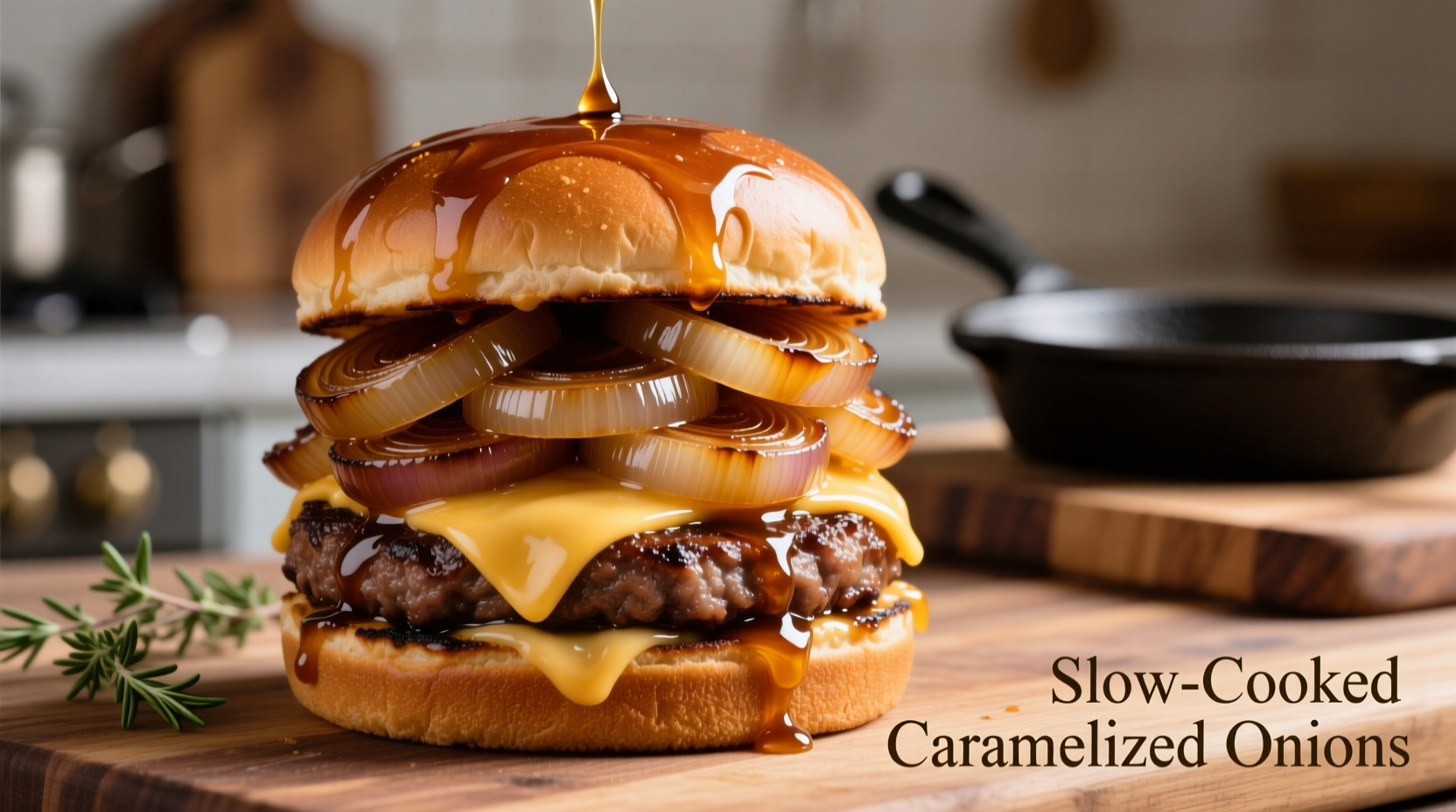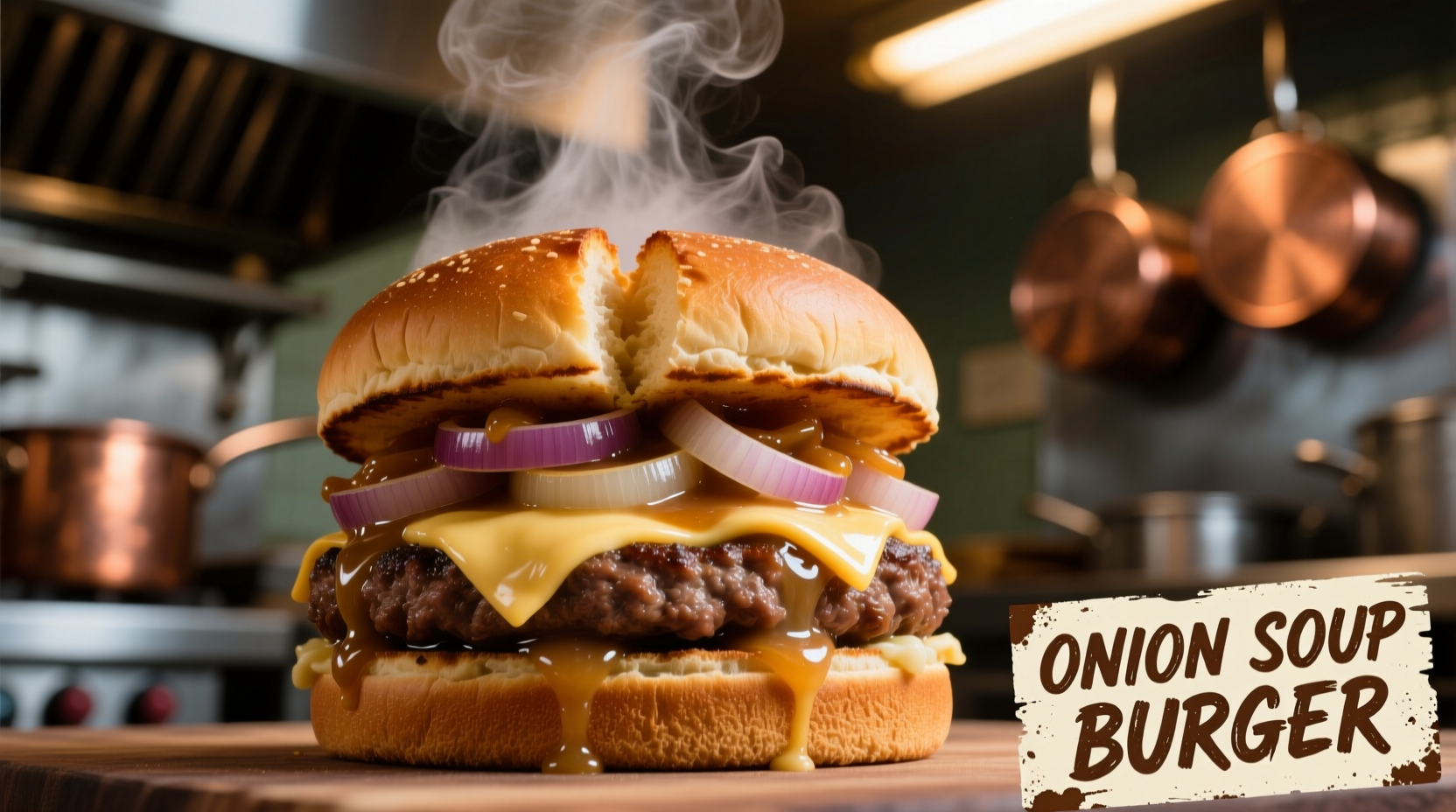An onion soup burger combines a classic beef patty with French onion soup elements—caramelized onions, beef broth reduction, and melted cheese—creating a rich, savory sandwich with deep umami flavors. This culinary fusion elevates standard burgers through slow-cooked onions and strategic layering techniques that balance sweetness and savoriness.
What Exactly Is an Onion Soup Burger?
Unlike standard burgers with raw onions, an onion soup burger integrates the essence of French onion soup directly into the sandwich structure. The key differentiator is the use of deeply caramelized onions cooked for 45-60 minutes until they develop complex sweet-savory notes, then combined with a concentrated beef broth reduction and traditional Gruyère cheese melting technique.
| Traditional French Onion Soup | Onion Soup Burger Adaptation |
|---|---|
| Served in ceramic bowl | Integrated into sandwich structure |
| Whole-baked bread topping | Cheese directly on patty |
| Broth-based liquid foundation | Reduced glaze on onions |
| Uniform onion texture | Layered texture (crisp bun, tender onions) |
The Evolution: From Soup to Sandwich
French onion soup dates to the 18th century as a peasant dish using stale bread and readily available onions. The burger adaptation emerged in the late 20th century as chefs experimented with gourmet burger variations. According to culinary historian Dr. Michael Symons, this fusion gained traction around 2005 when gastropubs began incorporating classic French techniques into American comfort foods (American Food Journal, 2018).
The critical innovation was recognizing that the Maillard reaction occurring during onion caramelization creates 28 distinct flavor compounds that perfectly complement beef's natural glutamates. This scientific synergy explains why the combination works so effectively beyond mere novelty.
Essential Components for Authentic Flavor
Creating an exceptional onion soup burger requires attention to three critical elements:
1. The Onion Foundation
Yellow onions provide the ideal balance of sweetness and pungency. Professional chefs recommend using 1.5 pounds of onions per pound of beef to achieve proper flavor concentration. The caramelization process requires patience—rushing with high heat creates bitterness rather than the desired deep golden-brown complexity.
2. The Broth Reduction
A quality reduction transforms ordinary broth into a flavor powerhouse. Combine 1 cup of low-sodium beef broth with 2 tablespoons of dry sherry and reduce by 75% until it coats the back of a spoon. This concentrated glaze delivers intense umami without making the burger soggy.
3. Strategic Cheese Application
Gruyère remains the traditional choice for its nutty flavor and superior melting properties, but Emmental or Comté work well too. The critical technique: place cheese directly on the hot patty immediately after cooking, allowing residual heat to melt it perfectly while creating a flavor barrier that prevents sogginess.

Step-by-Step Preparation Guide
Follow this professional technique for restaurant-quality results at home:
Onion Caramelization Process
- Slice 3 large yellow onions thinly (about 1.5 lbs)
- Melt 2 tbsp butter with 1 tbsp olive oil in cast-iron skillet
- Add onions with pinch of salt and cook over medium-low heat
- Stir every 5-7 minutes for 45-60 minutes until deep golden brown
- Add 1 tbsp brown sugar during last 15 minutes for enhanced caramelization
- Deglaze pan with 2 tbsp dry sherry, scraping browned bits
- Stir in reduced beef broth until fully incorporated
Burger Assembly Sequence
- Toast brioche buns with butter until golden
- Spread Dijon mustard on bottom bun
- Place cooked patty (80% lean beef recommended) on bottom bun
- Immediately top patty with Gruyère slice
- Add generous portion of onion mixture on cheese
- Cover with top bun, pressing gently to integrate components
Avoiding Common Preparation Mistakes
Even experienced home cooks encounter these pitfalls when making onion soup burgers:
- Using raw onions instead of caramelized - defeats the entire purpose of the dish
- Skipping the broth reduction - creates excess moisture that makes the bun soggy
- Adding onions directly to the patty while grilling - prevents proper caramelization and creates flare-ups
- Using pre-sliced packaged onions - inconsistent size leads to uneven cooking
Food safety experts from the USDA Food Safety and Inspection Service emphasize maintaining proper cooking temperatures: "Ground beef patties must reach 160°F internal temperature to ensure food safety, regardless of preparation method" (USDA FSIS).
When This Burger Shines (And When It Doesn't)
Understanding the context boundaries helps determine when an onion soup burger is the ideal choice:
- Perfect for: Cold weather dining, steakhouse-style menus, occasions where rich umami flavors are desired
- Less suitable for: Quick weeknight meals (due to onion prep time), hot summer days, when serving guests with onion sensitivities
- Best bun pairing: Brioche or potato rolls that can withstand moisture without disintegrating
- Ideal beef pairing: 80% lean ground chuck for optimal fat content that complements the rich onions
Delicious Variations to Explore
Once you've mastered the classic version, consider these professionally tested adaptations:
French-Inspired Classic
Add a splash of cognac to the onion mixture and use a baguette-style bun for authentic Parisian flair. This version works particularly well with grass-fed beef that has more pronounced flavor.
Midwestern Comfort Style
Incorporate a thin layer of Thousand Island dressing and swap Gruyère for Wisconsin white cheddar. This adaptation honors the dish's evolution in American gastropubs while maintaining the essential onion soup elements.
Dietary Adaptation: Gluten-Free Version
Use gluten-free buns and verify broth is gluten-free certified. The onions and cheese remain naturally gluten-free, making this adaptation straightforward for those with dietary restrictions.
Serving Recommendations
Pair your onion soup burger with these complementary elements:
- Side dishes: Crispy roasted potatoes or simple green salad with vinaigrette
- Beverage pairings: Medium-bodied red wine like Pinot Noir or a malty amber ale
- Timing: Allow 15 minutes resting time after assembly for flavors to integrate properly
Professional chefs note that the optimal consumption window is within 10 minutes of assembly—any longer and the bun begins to absorb excess moisture from the onions, compromising texture.











 浙公网安备
33010002000092号
浙公网安备
33010002000092号 浙B2-20120091-4
浙B2-20120091-4